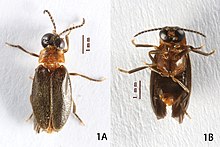Subfamily of beetles
The Ototretinae are a small subfamily in the firefly family (Lampyridae ).[ 1] Luciolinae in some respects, but do not glow or flash. Rather, they attract their partners with pheromones like many relatives of the firefly family. They are found in Eurasia and North America .[ 2]
They have sometimes been included in the Luciolinae : as the Ototretini , but it appears that this tribe may not be monophyletic ; the puzzling Stenocladius Cyphonocerinae to be included there.[ 2]
Genera
BioLib includes the following genera:[ 3]
Baolacus Pic, 1915 Brachylampis Van Dyke, 1939 Brachypterodrilus Pic, 1918 Ceylanidrilus Pic, 1911 Drilaster Kiesenwetter, 1879 Emasia Bocakova and Janisova, 2010 Eugeusis Westwood, 1853 Falsophaeopterus Pic, 1911 Flabellopalpodes Bocakova and Bocak, 2016 Flabellototreta Pic, 1911 Gorhamia Pic, 1911 Harmatelia Walker, 1858 Hydaspoides Bocakova and Janisova, 2013 Hyperstoma Wittmer, 1979 Lamellipalpodes Maulik, 1921 Lamellipalpus Maulik, 1921 Oculogryphus Jeng, Engel & Yang, 2007 (may be placed incertae sedis [ 1] Ototretadrilus Pic, 1921 Picodrilus Wittmer, 1938 Stenocladius Deyrolle & Fairmaire, 1878 Ototretadrilus [ 4]
References
^ a b Martin, Gavin J; Stanger-Hall, Kathrin F; Branham, Marc A; Da Silveira, Luiz F L; Lower, Sarah E; Hall, David W; Li, Xue-Yan; Lemmon, Alan R; Moriarty Lemmon, Emily; Bybee, Seth M (2019-11-01). Jordal, Bjarte (ed.). "Higher-Level Phylogeny and Reclassification of Lampyridae (Coleoptera: Elateroidea)". Insect Systematics and Diversity . 3 (6). Oxford University Press (OUP). doi :10.1093/isd/ixz024 . ISSN 2399-3421 . ^ a b Kathrin F. Stanger-Hall, James E. Lloyd & David M. Hillis (2007). "Phylogeny of North American fireflies (Coleoptera: Lampyridae): implications for the evolution of light signals". Molecular Phylogenetics and Evolution 45 (1): 33– 49. doi :10.1016/j.ympev.2007.05.013 . PMID 17644427 . ^ BioLib.cz: subfamily Ototretinae McDermott, 1964 (retrieved 25 June 2020) ^ Janisova, Kristyna; Bocakova, Milada (2013). "Revision of the subfamily Ototretinae (Coleoptera: Lampyridae)" . Zoologischer Anzeiger - A Journal of Comparative Zoology . 252 (1): 1– 19. Bibcode :2013ZooAn.252....1J . doi :10.1016/j.jcz.2012.01.001 .
